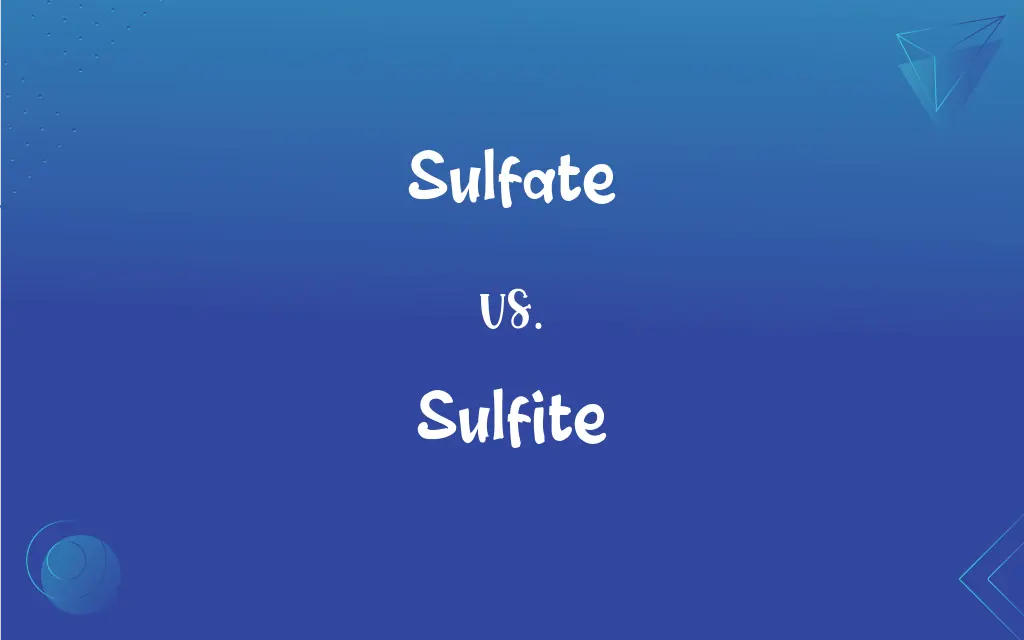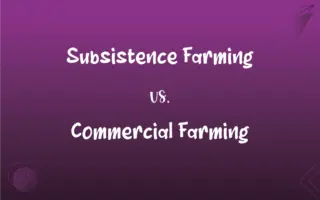Sulfate vs. Sulfite: What's the Difference?
Edited by Aimie Carlson || By Harlon Moss || Updated on October 19, 2023
Sulfates (SO₄²⁻) are salts or esters of sulfuric acid containing the anion SO₄²⁻, while sulfites (SO₃²⁻) are salts or esters of sulfurous acid containing the anion SO₃²⁻.

Key Differences
Sulfates and sulfites are both anions derived from sulfur. However, they differ in their chemical structure and properties. Sulfates are derived from sulfuric acid and possess the chemical formula SO₄²⁻. They are used in various industries, from the production of detergents to the manufacturing of paper.
Sulfites, on the other hand, are derived from sulfurous acid and have the chemical formula SO₃²⁻. They're commonly known for their role as preservatives in foods and wines. Sulfites help prevent the growth of harmful bacteria and maintain the color and freshness of the product.
Another key difference between sulfates and sulfites lies in their oxidation state of sulfur. In sulfates, sulfur is in the +6 oxidation state, whereas in sulfites, it's in the +4 oxidation state. This distinction affects their reactivity and the kind of compounds they form.
Sulfates are often found in the environment due to their widespread use in industries. They can sometimes cause environmental issues when released in large quantities. Sulfites, on the other hand, have garnered attention due to potential allergic reactions in some individuals when consumed.
Health concerns related to sulfates and sulfites differ. While sulfates are generally considered safe for most, some might find them drying on the skin in personal care products. Sulfites, in contrast, might pose allergic reactions in some individuals when ingested, leading to regulations on their labeling in food products.
ADVERTISEMENT
Comparison Chart
Chemical Formula
SO₄²⁻
SO₃²⁻
Origin Acid
Sulfuric acid
Sulfurous acid
Oxidation State of Sulfur
+6
+4
Common Use
Detergents, paper manufacturing
Food and wine preservative
Health Concerns
Potentially drying on the skin
Potential for allergic reactions when ingested
ADVERTISEMENT
Sulfate and Sulfite Definitions
Sulfate
An anion with the chemical formula SO₄²⁻.
The sulfate ion is a central component of many minerals.
Sulfite
A salt or ester of sulfurous acid.
Sodium sulfite is frequently used in the paper industry.
Sulfate
A group of atmospheric pollutants that can lead to acid rain.
Coal combustion releases sulfur dioxide, which can convert to sulfates in the atmosphere.
Sulfite
A compound commonly used as a preservative in food and drinks.
Winemakers often add sulfites to wines to extend shelf life.
Sulfate
A compound that contains the divalent group —OSO₂O—.
Sodium lauryl sulfate is a common ingredient in shampoos.
Sulfite
An anion with the chemical formula SO₃²⁻.
The sulfite ion can act as a reducing agent in certain reactions.
Sulfate
A chemical agent used in various industries, from textiles to metallurgy.
Copper sulfate is employed in agriculture to control fungus on grapes and other crops.
Sulfite
A chemical agent utilized in the photographic industry.
Photographers use sulfites in developing solutions to preserve image quality.
Sulfate
A salt or ester of sulfuric acid.
Calcium sulfate is commonly used in the production of plaster.
Sulfite
A group of compounds that can cause allergic reactions in sensitive individuals.
Foods containing sulfites must be labeled to warn potential consumers.
Sulfate
The divalent group SO4 or a compound containing this group.
Sulfite
The divalent anionic group SO3, derived from sulfurous acid, or a compound containing this group.
Sulfite
Any salt of sulfurous acid.
FAQs
Why are sulfites added to wine?
Sulfites preserve freshness and prevent bacterial growth in wines.
Are sulfates and sulfites the same?
No, they are different in their chemical structure and uses.
Where are sulfites commonly used?
Sulfites are often used in the food and beverage industry as preservatives.
Are sulfates found in shampoos?
Yes, some shampoos contain sulfates like sodium lauryl sulfate.
Can sulfites cause allergic reactions?
Yes, some people are sensitive to sulfites and can experience allergic reactions.
Is sulfate a natural mineral?
Yes, sulfates occur naturally in minerals like gypsum.
Do sulfates and sulfites taste different?
They don't have distinct tastes, but sulfites can influence the taste of foods or drinks they're added to.
What's the chemical formula for sulfate?
The formula for sulfate is SO₄²⁻.
How about the formula for sulfite?
The formula for sulfite is SO₃²⁻.
Can sulfates be used in agriculture?
Yes, some sulfates, like copper sulfate, are used as fungicides.
Can I find sulfite-free wines?
Yes, there are sulfite-free wines available for those who are sensitive.
Can sulfites be used in photography?
Yes, sulfites are used in photographic solutions to preserve image quality.
How can I identify a sulfate on a product label?
Look for ingredients like "sodium lauryl sulfate" or terms ending in "-sulfate."
Are there regulations about sulfite labeling?
Yes, foods containing sulfites must be labeled due to potential allergic reactions.
Which has a higher oxidation state, sulfate or sulfite?
Sulfate has a higher oxidation state (+6) than sulfite (+4).
Are sulfates present in household cleaners?
Yes, some household cleaners contain sulfates for their cleaning properties.
Are there natural sources of sulfates?
Yes, sulfates are naturally found in some mineral springs and waters.
Are sulfites in dried fruits?
Yes, sulfites are often used to preserve the color and freshness of dried fruits.
Are sulfates considered pollutants?
In large quantities, sulfates can contribute to environmental issues like acid rain.
Are sulfites used in the paper industry?
Yes, sulfites are used in certain processes of paper production.
About Author
Written by
Harlon MossHarlon is a seasoned quality moderator and accomplished content writer for Difference Wiki. An alumnus of the prestigious University of California, he earned his degree in Computer Science. Leveraging his academic background, Harlon brings a meticulous and informed perspective to his work, ensuring content accuracy and excellence.
Edited by
Aimie CarlsonAimie Carlson, holding a master's degree in English literature, is a fervent English language enthusiast. She lends her writing talents to Difference Wiki, a prominent website that specializes in comparisons, offering readers insightful analyses that both captivate and inform.
































































